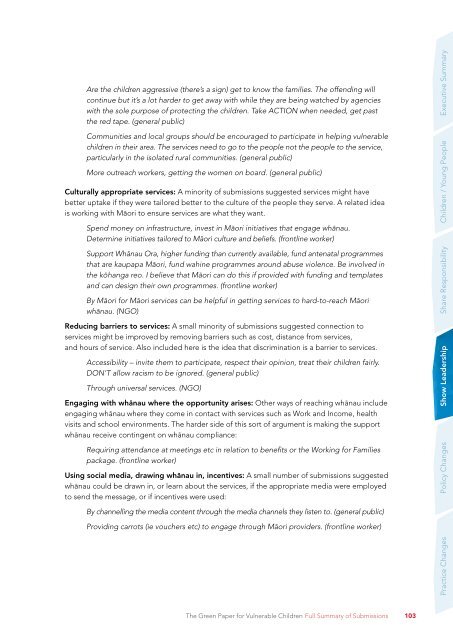The Green Paper for Vulnerable Children - Ministry of Social ...
The Green Paper for Vulnerable Children - Ministry of Social ...
The Green Paper for Vulnerable Children - Ministry of Social ...
Create successful ePaper yourself
Turn your PDF publications into a flip-book with our unique Google optimized e-Paper software.
Are the children aggressive (there’s a sign) get to know the families. <strong>The</strong> <strong>of</strong>fending willcontinue but it’s a lot harder to get away with while they are being watched by agencieswith the sole purpose <strong>of</strong> protecting the children. Take ACTION when needed, get pastthe red tape. (general public)Communities and local groups should be encouraged to participate in helping vulnerablechildren in their area. <strong>The</strong> services need to go to the people not the people to the service,particularly in the isolated rural communities. (general public)More outreach workers, getting the women on board. (general public)Culturally appropriate services: A minority <strong>of</strong> submissions suggested services might havebetter uptake if they were tailored better to the culture <strong>of</strong> the people they serve. A related ideais working with Māori to ensure services are what they want.Spend money on infrastructure, invest in Māori initiatives that engage whānau.Determine initiatives tailored to Māori culture and beliefs. (frontline worker)Support Whānau Ora, higher funding than currently available, fund antenatal programmesthat are kaupapa Māori, fund wahine programmes around abuse violence. Be involved inthe kōhanga reo. I believe that Māori can do this if provided with funding and templatesand can design their own programmes. (frontline worker)By Māori <strong>for</strong> Māori services can be helpful in getting services to hard-to-reach Māoriwhānau. (NGO)Reducing barriers to services: A small minority <strong>of</strong> submissions suggested connection toservices might be improved by removing barriers such as cost, distance from services,and hours <strong>of</strong> service. Also included here is the idea that discrimination is a barrier to services.Accessibility – invite them to participate, respect their opinion, treat their children fairly.DON’T allow racism to be ignored. (general public)Through universal services. (NGO)Engaging with whānau where the opportunity arises: Other ways <strong>of</strong> reaching whānau includeengaging whānau where they come in contact with services such as Work and Income, healthvisits and school environments. <strong>The</strong> harder side <strong>of</strong> this sort <strong>of</strong> argument is making the supportwhānau receive contingent on whānau compliance:Requiring attendance at meetings etc in relation to benefits or the Working <strong>for</strong> Familiespackage. (frontline worker)Using social media, drawing whānau in, incentives: A small number <strong>of</strong> submissions suggestedwhānau could be drawn in, or learn about the services, if the appropriate media were employedto send the message, or if incentives were used:By channelling the media content through the media channels they listen to. (general public)Providing carrots (ie vouchers etc) to engage through Māori providers. (frontline worker)Practice Changes Policy Changes Show Leadership Share Responsibility <strong>Children</strong> / Young People Executive Summary<strong>The</strong> <strong>Green</strong> <strong>Paper</strong> <strong>for</strong> <strong>Vulnerable</strong> <strong>Children</strong> Full Summary <strong>of</strong> Submissions103
















